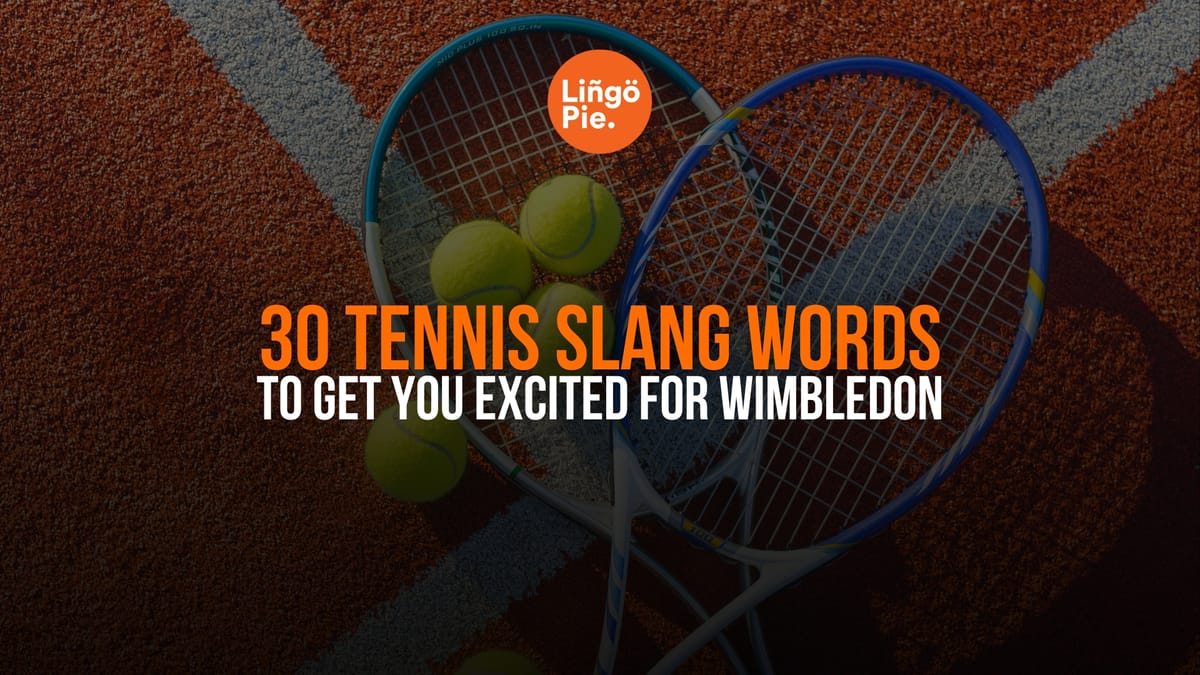Every summer, tennis fans worldwide turn their attention to London for one of the sport’s most iconic events: Wimbledon. In 2025, the tournament returns for its 138th edition, bringing world-class talent, dramatic rallies, and plenty of on-court storylines to the grass courts of the All England Club.
But watching tennis is about more than just the score. To really follow the action and feel like part of the global fan community, you need to speak the language of the sport. In this post, we rounded up the top tennis slang terms you need to know by heart.
- 22+ Japanese Slang Words The Locals ACTUALLY USE
- 140 Essential Phrases In Spanish For Travelers
- 19+ Hilarious British Slang Terms to Spice Up Your Vocab

What Is Wimbledon 2025?
Wimbledon 2025 is the 138th edition of the world’s oldest and most prestigious Grand Slam13 July tennis tournament, held at the All England Club in London from 30 June to 13 July 2025. Played entirely on meticulously maintained grass courts, it features a 128-player singles draw, doubles and mixed doubles events, and total prize money of £53,550,000.
Centre Court, Court One, and the famed “Graveyard of Champions” host the biggest matches, with seating capacities ranging from 4,000 to nearly 15,000. Top‐ranked players like Jannik Sinner, Carlos Alcaraz, and Novak Djokovic in the men’s draw and Aryna Sabalenka, Iga Świątek, and Barbora Krejcikova in the women’s draw are among the seeded competitors aiming for glory.
Popular Players And The Languages They Speak
Learning a new language feels easier when you link it to people you admire. Many top pros at Wimbledon grew up bilingual or became polyglots on tour, proving that linguistic curiosity and athletic excellence often go hand in hand. Here are a few stars whose language stories might give you extra motivation:
Novak Djokovic
The Serbian great is famous for chatting with journalists in six tongues: Serbian, English, French, German, Italian, and Spanish. He credits those skills to a childhood fascination with cultures he encountered while training abroad.
Iga Świątek
The Polish world number one regularly flips between Polish and fluent English in press rooms. She has said that reading English novels helped her vocabulary almost as much as hitting cross-court forehands helped her ranking.
Jannik Sinner
Raised in German-speaking South Tyrol before moving to Italy for tennis, Sinner grew up speaking German at home and learned Italian only after age thirteen; he now gives interviews smoothly in both languages and in English as well.
Carlos Alcaraz
Spain’s defending Wimbledon champion conducts most media in Spanish but has been steadily refining his English since his teen breakthrough, eager to connect with the wider tour and its global fan base.
Aryna Sabalenka
Belarus’s powerhouse speaks Belarusian and Russian at home and gives most of her interviews in confident English, something she polished while climbing the rankings on the North American circuit.

Tennis Slang Terms Every Fan Should Know
1. Bagel
A bagel refers to winning or losing a set 6-0, with the zero's round shape resembling a bagel. When you hear "she handed out a bagel," someone just dominated completely. It's actually more common than you'd think in early tournament rounds.
2. Breadstick
A breadstick means winning or losing a set 6-1, with the straight shape of the "1" supposedly resembling a breadstick. It's bagel's slightly less devastating cousin. Getting breadsticked still stings, but at least you managed to win one game.
3. Double Bagel
This means winning two sets 6-0—the tennis equivalent of a shutout in other sports. It's rare enough that it makes headlines when it happens at major tournaments.
4. Golden Set
An extremely rare bagel where the winner doesn't lose a single point. This has happened so few times in professional tennis that each occurrence becomes tennis folklore. Think of it as tennis's equivalent of a perfect game in baseball.

5. Love
In tennis, love means zero, and no, it's not because the sport is romantic. The term likely comes from the French "l'œuf" (egg), because an egg's shape resembles zero. When the score is "30-love," one player has 30 points and the other has zero.
6. Ace
An ace is a perfect serve that the receiver can't touch, landing in the service box and giving the server an immediate point. It's the server's ultimate weapon. When someone's serving aces consistently, they're in the zone.
7. Moonball
A high, loopy shot that reaches for the heavens and lands deep in the opponent's court. It looks slow and harmless, but can be surprisingly effective at disrupting rhythm. Some players hate facing moonballers because it throws off their timing completely.
8. Drop Shot
A soft shot that barely clears the net and forces your opponent to sprint forward. It's tennis's version of a fake-out play. The best drop shots leave opponents scrambling and often arriving too late.
9. Overhead (Smash)
A shot hit above the head, usually in response to a lob, also known as a smash. It's one of tennis's most satisfying shots when executed properly. The crowd always loves a good overhead winner.

10. Sledgehammer
A crushing two-handed backhand winner blasted straight down the line—a statement shot with raw power and precision. When someone hits a sledgehammer, opponents don't chase it; they just watch and wince.
11. Serve and Volley
A style where you serve and immediately rush to the net to intercept the return as a volley. It's classic old-school tennis that's less common today but still thrilling to watch. Players like John McEnroe made this style famous.
12. Chip and Charge
Hitting a slice or angled serve, then immediately running to the net. It's an aggressive tactical move designed to put pressure on your opponent. The risk is high, but so is the reward when it works.
13. Down the Line
A ball hit straight along the sideline to the opponent's side of the court. It's often used to surprise an opponent who's expecting a cross-court shot. The margin for error is small, but the payoff is big.
14. Break Point
A point which, if won by the receiver, would result in breaking the server's service game. These are the moments when matches can shift dramatically. The pressure at break point is intense, as it can change the entire momentum of a match.
15. Deuce
When both players reach 40-40, creating a tie that requires one player to win two consecutive points. Deuce games can go on forever, creating some of tennis's most nail-biting moments.

16. Advantage (Ad)
When a player wins the point after deuce, they have "advantage." If the server has advantage, it's "ad in"; if the receiver has it, it's "ad out." One more point wins the game from here.
17. Let
When a serve touches the net but still lands in the service box, requiring the serve to be replayed. It's tennis's version of a do-over. Let serves can be frustrating for players trying to maintain rhythm.
18. Foot Fault
When a player steps on or over the baseline during their serve before striking the ball. It results in a fault, just like hitting the net or serving out of bounds. Professional players rarely commit foot faults, but recreational players do it all the time.
19. Frame Shot
A mishit where the ball strikes the racket frame instead of the strings. These shots are unpredictable and often lucky. Sometimes frame shots produce winners that regular shots couldn't achieve.
20. Pusher
A player who focuses on consistency over power, often frustrating aggressive opponents with steady, safe shots. Pushers rarely hit winners but force opponents into errors. They're the marathon runners of tennis—they'll outlast you if you're not careful.

21. Big Server
A player whose main weapon is a powerful serve. Players like this can dominate on grass courts like Wimbledon where the surface favors serving. When big servers are on, they're nearly unbreakable.
22. Baseliner
A player who prefers staying at the back of the court, playing most points from the baseline. Most modern players are baseliners, as the game has evolved toward power and consistency from the back of the court.
23. Tweener
A trick shot played between the legs, typically used when chasing down a lob. It's high risk, high reward tennis at its most entertaining. When tweeners work, they bring crowds to their feet.
24. Hot Dog
Another term for a tweener or any flashy, showboat shot. It's tennis with maximum swagger—use only if you're feeling spicy. Hot dog shots are crowd-pleasers but can backfire spectacularly.
25. Daisy Cutter
A low shot that skids or takes a very low bounce, usually due to adding slice. On grass courts like Wimbledon, daisy cutters can be particularly effective because the surface naturally keeps balls low.

26. Can Opener
A serve hit with slice that lands near the intersection of the singles line and service line. It's called a can opener because it "opens up" the court by pulling the receiver wide. Lefties are particularly good at this serve to right-handed players.
27. Choke
When a player loses their nerve in a crucial moment and makes uncharacteristic errors. Everyone chokes sometimes—it's part of what makes tennis so mentally challenging. The pressure at Wimbledon can make even the best players choke.
28. On Fire (or "Treeing")
When a player is hitting every line, making every shot, and playing way above their usual level. These magical stretches are what make tennis unpredictable and exciting. Players describe being "in the zone" during these moments.
29. Tanking
When a player appears to give up or stop trying in a match. It's controversial and generally frowned upon. Professional players can face fines for tanking, as it undermines the sport's competitive integrity.
30. Brutalizer
Smashing the ball directly at your opponent—legal but not exactly friendly. It's aggressive tennis that can intimidate opponents. Sometimes brutalizing is strategic; sometimes it's just frustration boiling over.
Why Tennis Slang Matters for Language Learners
If you’re already on a language learning journey, tennis slang offers a perfect case study in how specialized vocabulary develops within communities. The creativity behind terms like "breadstick" and "bagel" shows how language naturally evolves, borrowing from everyday objects to describe specific situations.
Plus, if you’re learning English or any foreign language like Italian or Spanish, where tennis is popular, understanding sports terminology gives you cultural currency. You'll catch references in movies, understand jokes in conversations, and feel more connected to the communities you’re trying to join.
Learn More with Lingopie
Now that you know the key tennis expressions, watching Wimbledon 2025 will be a whole new experience. When a player serves bagels or sends moonballs across the court, you will not only recognize the moves but also understand the drama behind them.
If you are a tennis fan, why not pursue your passion further? Whether you admire Carlos Alcaraz, Iga Świątek, or any international star, learning their language brings you closer to the sport and its culture. It is a chance to connect with interviews, commentary, and fan communities in a way you never could before.
Lingopie’s advanced features help you do that naturally. By watching real shows, interviews, and matches in your target language, you absorb vocabulary the way native speakers do—through real-life context, not memorization. If this article sparked your curiosity, let Lingopie turn it into a new language journey.
FAQ: Tennis Terminology Decoded
What do tennis players yell?
Tennis players commonly yell "Come on!" for motivation, though you’ll also hear various exclamations in their native languages during intense moments. The most iconic tennis sound might be the grunting that some players produce when hitting powerful shots—this helps with timing and power generation. Official calls like "out!" or "fault!" come from line judges and umpires, not the players themselves.
What is slang for tennis?
Common slang terms for the sport of tennis include "the court game," "racquet sport," and informally just "hitting" or "playing." Some players and fans refer to it as "the net game" to distinguish it from other racket sports. In casual conversation, you might hear people say they're going to "hit some balls" or "play some tennis," though tennis doesn't have as many alternative names as some other sports.
What is a tennis hit called?
Tennis shots have specific names depending on technique and situation: groundstrokes (forehand and backhand from the baseline), volleys (shots hit before the ball bounces), serves (starting each point), and overheads or smashes (shots hit above the head). Specialty shots include drop shots (soft shots that barely clear the net), lobs (high shots hit over an opponent), and passing shots (shots hit past a net-rushing opponent).
What does SGL mean in tennis?
SGL stands for "singles" in tennis tournament draws and scheduling, distinguishing individual matches from doubles (DBL) competition, where two players team up on each side. You'll see SGL used in official tournament documentation, TV graphics, and scheduling information to identify the format of upcoming matches quickly.









![Foreigner's Guide To Hangeul Day In Korea [2025]](/blog/content/images/size/w300/2024/10/Apprendre-Des-Gros-Mots-Faciles-En-Allemand-2.png)